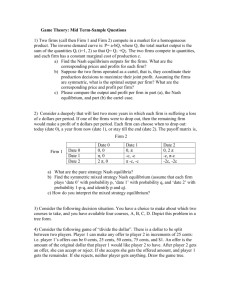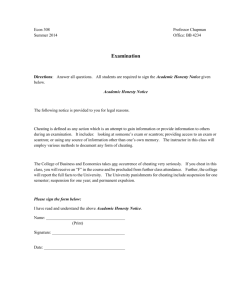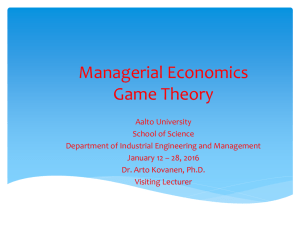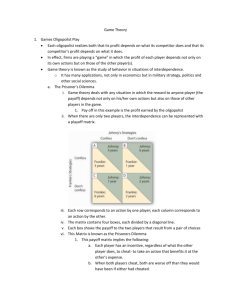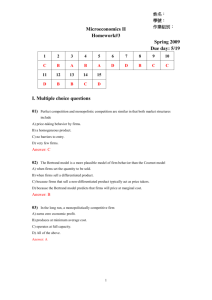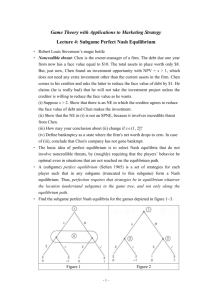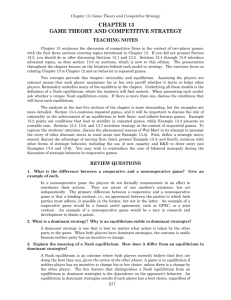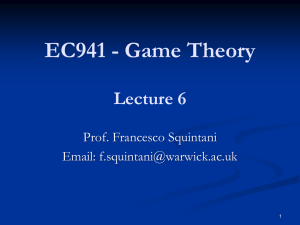Homework #2 - Oregon State University
advertisement
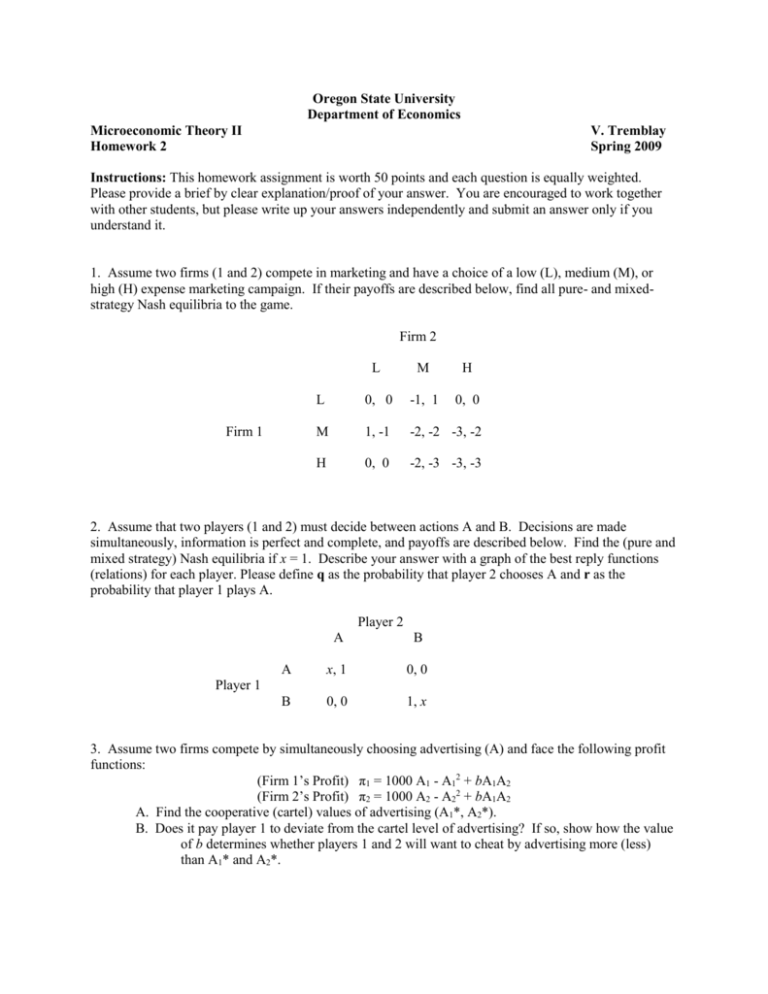
Oregon State University Department of Economics Microeconomic Theory II Homework 2 V. Tremblay Spring 2009 Instructions: This homework assignment is worth 50 points and each question is equally weighted. Please provide a brief by clear explanation/proof of your answer. You are encouraged to work together with other students, but please write up your answers independently and submit an answer only if you understand it. 1. Assume two firms (1 and 2) compete in marketing and have a choice of a low (L), medium (M), or high (H) expense marketing campaign. If their payoffs are described below, find all pure- and mixedstrategy Nash equilibria to the game. Firm 2 Firm 1 L M H L 0, 0 -1, 1 0, 0 M 1, -1 -2, -2 -3, -2 H 0, 0 -2, -3 -3, -3 2. Assume that two players (1 and 2) must decide between actions A and B. Decisions are made simultaneously, information is perfect and complete, and payoffs are described below. Find the (pure and mixed strategy) Nash equilibria if x = 1. Describe your answer with a graph of the best reply functions (relations) for each player. Please define q as the probability that player 2 chooses A and r as the probability that player 1 plays A. Player 2 A B A x, 1 0, 0 B 0, 0 1, x Player 1 3. Assume two firms compete by simultaneously choosing advertising (A) and face the following profit functions: (Firm 1’s Profit) π1 = 1000 A1 - A12 + bA1A2 (Firm 2’s Profit) π2 = 1000 A2 - A22 + bA1A2 A. Find the cooperative (cartel) values of advertising (A1*, A2*). B. Does it pay player 1 to deviate from the cartel level of advertising? If so, show how the value of b determines whether players 1 and 2 will want to cheat by advertising more (less) than A1* and A2*. 4. Consider a game where each of 10 players chooses a number between 0 and 1,000. Choices are made simultaneously and communications is impossible. The mean of the chosen numbers is x, and y ≡ (2/3)x. The player whose chosen number is closest to y wins $1,000. Everyone else wins 0. What is the Nash equilibrium to this game? 5. Consider a duopoly market, where firms 1 and 2 compete by choosing prices. The demand and cost functions are defined as follows. (Firm i’s Demand) qi = 12 - pi + pj (Total Cost) TCi = 0. Note that subscript i represents firms 1 or 2 and subscript j represent i’s rival. A. Determine the Nash equilibrium if firms choose price simultaneously. B. Determine the SPNE if firm 1 chooses price first and firm 2 chooses price second. Information is perfect and complete. C. Determine the subgame perfect equilibrium if the timing is the same as in part B above. In this case, however, firm 2 has imperfect information about firm 2's action. That is, firm 2 knows that firm 1 has made a decision but does not know the price chosen by firm 1. 6. Consider a monopoly market with just two periods (1 and 2). The firm produces a durable good. That is, goods produced in period 1 are of use in periods 1 and 2. Goods produced in period 2 are of use in period 2 only. There is no period 3. Costs are normalized to 0, and the market demand functions for each period are listed below: (Inverse Demand in Period 1) p1 = (a - b q1) + [a - b (q1 + q2 )] (Inverse Demand in Period 2) p2 = a - b (q1 + q2 ), where a and b are positive constants. A. Determine the firm’s optimal price and output for each period if the firm chooses to maximize joint profits (i.e., period 1 profits plus period 2 profits). B. Determine the SPNE to this game. C. Which outcome will be more likely for the monopolist? That is, explain why it will be very difficult for the firm to behave as a joint profit maximizer once period 2 arrives. 7. Consider a duopoly market where firms compete in output. Can the leader ever get a lower profit in a (dynamic) Stackelberg equilibrium compared to the profit in a (static) Cournot equilibrium? 8. Consider a bilateral monopoly problem where a small company town has a firm that is a monopoly buyer of labor and a union that is a monopoly seller of labor. The profit function of the firm (π) and the utility function of the union (U) are listed below: (Firm Profit) π = a L - b L2 - w L (Union Utility) U = w L, where L is the quantity of labor employed by the firm, w is the price of labor, and “a” and “b” are positive constants. The firm and union bargain over employment and wages as follows: Stage I: the union decides w > 0. Stage II: after observing w, the firm chooses L. The firm’s objective is to maximize profit, and the union’s objective is to maximize utility. Information is perfect and complete. Determine the subgame perfect equilibrium L, w, π, and U to this game. 9. Consider another bilateral monopoly problem where two agents (1 and 2) bargain over a total payoff. Because each agent is impatient, the present value of the total payoff (π) depreciates as time passes: Stage I: π = 1 Stage II: π = 3/6 Stage III: π = 1/6 Stage IV: π = 0 Assume the following bargaining rules. Stage I: Player 1 makes an offer to player 2. If 2 accepts, the game is over and the payoff is split as offered. If rejected, player 2 makes an offer in the next stage. Stage II: Player 2 makes an offer to player 1. If 1 accepts, the game is over and the payoff is split as offered. If rejected, player 1 makes an offer in the next stage. Stage III: Player 1 makes an offer to player 2. If 2 accepts, the game is over and the payoff is split as offered. If rejected, the game is over and they each receive 0. Find the SPNE to the bargaining game if players have perfect and complete information. 10. Considered a repeated game where n firms compete by simultaneously choosing price in each stage game. Products are homogeneous, long-run average and marginal costs are constant (at c), and information is perfect and complete. A. If n = 2 and the game is played only once, describe the Nash equilibrium to this game. B. If n = 2 and the game is played or repeated 10 times, describe the subgame perfect equilibrium to this game. C. If n = 2 and the game is played an infinite number of times, describe the SPNE. What values of the discount factor will support cooperation? D. If n ε [2, ∞) and the game is played an infinite number of times, describe the SPNE. If the discount factor is 0.9, what values of n will support cooperation? 11. Consider a market with n firms that compete by simultaneously choosing price (p) and advertising (A). The demand and cost functions are defined as follows. (Firm i’s Demand) qi = a - b pi + d p’ + e Ai + f A’ (Total Cost) TCi = c qi + g(s) ⋅A2i, where a, b, c, d, e, and f, are positive constants, b > d, and e > f. Function g(s) depends on the value of s. Note that p’ is defined as the average price of firm i’s rivals and A’ is the sum of the advertising expenditures of firm i’s rivals. A. What assumptions are needed to assure that the game is supermodular (i.e., dg/ds = ?). B. Assume the government is considering a policy that will raises s. Explain how you would determine the effect of a change in s on the profit maximizing levels of p and A if the game is supermodular. 12. Consider a pure exchange economy with two consumers (A and B) and two goods (x and y). The utility functions and initial endowments are described below. UA = f(xA, yA); UB = f(xB, yB) xA = 78, yA = 0, xB = 0, yB = 164 Use an Edgeworth box diagram to identify the contract curve, the core, and the relative prices that will generate a competitive equilibrium for this economy. 13. Consider an economy with two consumers (A and B) and two goods (x and y). The production possibility function (PPC), utility functions (U), and social welfare function (S) are identified below. PPC: x2 + y2 = 50 UA = xA yA ; UB = xB yB S = (UA UB)1/2 A. Draw the Edgeworth box and identify the contract curve for these consumers when x = 1 and y = 7. B. Determine how much x and y should be produced in this economy and consumed by each consumer in order to ensure Pareto optimality. Describe your answer with a single diagram of the PPC, Edgeworth box, and contract curve. C. Determine how much x and y should be produced and consumed by each consumer in order to maximize social welfare. 14. Use an Edgworth box diagram to show that there are gains from trade in a two person, pure exchange economy. Under what conditions will there be no gains from trade? 15. Assume two firms (1 and 2) operate in different but perfectly competitive markets. Firm 1 imposes a negative externality on firm 2, as reflected in the total cost functions below. TC1 = (q12)/2 and TC2 = q22 + 2 q1 . If firm 1 faces an equilibrium price of p1 and firm 2 faces an equilibrium price of p2, A. Calculate the private optimum output for each firm. B. Calculate the social optimum output for each firm. C. What is the marginal damage that firm 1 imposes on firm 2? D. Show how a Pigovian tax can be used to solve the inefficiency associated with this externality. 16. Assume a two consumer (A and B) world, where consumers have the following individual demand functions for a purely public good (G): G = 20 - pA and G = 16 - 2pB, where G = GA = GB. If the total cost of producing the public good is 10G, determine the Pareto optimal level of G. 17. Assume that firms have access to a resource that no one owns. This resource is called a commons because it is freely available to everyone. Assume further that the resource produces total profits (Π) based on the total number of users of the resource (n) as follows: Π = 1.2 n - 0.1 n2 Each firm that uses the resource earns an average profit (i.e. Π/n) and will use it as long as its profit does not fall below 0.1. Show that the Nash equilibrium number of firms will exceed the Pareto optimal number of firms.
